Thu, Oct 30, 2025
[Archive]
Volume 4, Issue 4 (11-2022)
IJMCL 2022, 4(4): 24-29 |
Back to browse issues page
Download citation:
BibTeX | RIS | EndNote | Medlars | ProCite | Reference Manager | RefWorks
Send citation to:



BibTeX | RIS | EndNote | Medlars | ProCite | Reference Manager | RefWorks
Send citation to:
Rostami R, Zeinali M, Pasand F, Garmanjani U. (2022). The Effect of Core Stability Training on Fundamental Motor Skills in Over-weight and Obese Girls. IJMCL. 4(4), 24-29. doi:10.52547/ijmcl.4.4.24
URL: http://ijmcl.com/article-1-134-en.html
URL: http://ijmcl.com/article-1-134-en.html
Associate Professor, Department of Motor Behavior, Faculty of Educational Sciences and Psychology, Shiraz University, Shiraz, Iran. , rostami@shirazu.ac.ir
Abstract: (3737 Views)
Background: With the increase in obesity and overweight statistics, it will be difficult to implement many movement skills from childhood. Among these skills, fundamental movement skills which are known as prerequisites for specialized skills need special attention. The purpose of the present research is to investigate the effect of core stability training on fundamental motor skills in overweight and obese girls. Methods: This research is of a quasi-experimental type. After school selection randomly and after initial screening, 30 girls’ students of 7 years (15 in the experimental group and 15 in the control group) were selected who were in the obese and overweight categories based on body mass index. Students Object Control and locomotor skills in the pre-test and post-test were assessed using Gross Motor Development Test 2 (TGMD2). The method of the present study was experimental and its design was pretest-posttest with a control group. Results: One-way analysis of covariance showed that core stability exercises can improve the fundamental motor skills of overweight and obese students. Conclusions: According to the findings of this study, by designing and implementing core stability exercises in primary schools, it is possible to help improve the fundamental motor skills (locomotor and ball skills) of children, especially children with motor deficits due to overweight and obesity.
Full-Text [PDF 436 kb]
(1534 Downloads)
- Fundamental movement skills are the foundation of specialized sports skills.
- The role of core stability exercises in children's movement patterns is very important.
- Growth charts provide useful information about children's body mass index.
Type of Study: Original Article |
Subject:
1. Motor learning
Received: 2022/08/4 | Accepted: 2022/11/6
Received: 2022/08/4 | Accepted: 2022/11/6
References
1. Alsakhawi, R. S., & Elshafey, M. A. (2019). Effect of core stability exercises and treadmill training on balance in children with Down syndrome: randomized controlled trial. Advances in therapy, 36(9), 2364-2373. [DOI:10.1007/s12325-019-01024-2]
2. Apache, R. G. (2005). Activity-based intervention in motor skill development. Perceptual and motor skills, 100(3_suppl), 1011-1020. [DOI:10.2466/pms.100.3c.1011-1020]
3. Boucher, F., Handrigan, G. A., Mackrous, I., & Hue, O. (2015). Childhood obesity affects postural control and aiming performance during an upper limb movement. Gait & posture, 42(2), 116-121. [DOI:10.1016/j.gaitpost.2015.04.016]
4. Bryant, E. S., Duncan, M. J., & Birch, S. L. (2014). Fundamental movement skills and weight status in British primary school children. European journal of sport science, 14(7), 730-736. [DOI:10.1080/17461391.2013.870232]
5. Butterfield, S. A., Lehnhard, R. A., & Coladarci, T. (2002). Age, sex, and body mass index in performance of selected locomotor and fitness tasks by children in grades K-2. Perceptual and motor skills, 94(1), 80-86. [DOI:10.2466/pms.2002.94.1.80]
6. Cabanas-Valdés, R., Bagur-Calafat, C., Girabent-Farrés, M., Caballero-Gómez, F. M., Hernández-Valiño, M., & Urrutia Cuchi, G. (2016). The effect of additional core stability exercises on improving dynamic sitting balance and trunk control for subacute stroke patients: a randomized controlled trial. Clinical rehabilitation, 30(10), 1024-1033. [DOI:10.1177/0269215515609414]
7. Carmeli, E., Zinger-Vaknin, T., Morad, M., & Merrick, J. (2005). Can physical training have an effect on well-being in adults with mild intellectual disability? Mechanisms of ageing and development, 126(2), 299-304. [DOI:10.1016/j.mad.2004.08.021]
8. Daniels, S. R. (2006). The consequences of childhood overweight and obesity. The future of children, 16(1), 47-67. [DOI:10.1353/foc.2006.0004]
9. Fisher, A., Reilly, J. J., Kelly, L. A., Montgomery, C., Williamson, A., Paton, J. Y., & Grant, S. (2005). Fundamental movement skills and habitual physical activity in young children. Med Sci Sports Exerc, 37(4), 684-688. [DOI:10.1249/01.MSS.0000159138.48107.7D]
10. Ghaedy, M., Rostami, R., Chahardah Cherik, M., & Khoshbakht, F. (2021). Comparison of The Effect of a Selected Training Period and Core Stability on Object Control Skills in 4-6 Years Old Children. International Journal of Motor Control and Learning, 3(4), 46-58. doi:10.52547/ijmcl.3.4.46 [DOI:10.52547/ijmcl.3.4.46]
11. Goodway, J. D., & Branta, C. F. (2003). Influence of a motor skill intervention on fundamental motor skill development of disadvantaged preschool children. Research quarterly for exercise and sport, 74(1), 36-46. [DOI:10.1080/02701367.2003.10609062]
12. Han, A., Fu, A., Cobley, S., & Sanders, R. H. (2018). Effectiveness of exercise intervention on improving fundamental movement skills and motor coordination in overweight/obese children and adolescents: A systematic review. Journal of science and medicine in sport, 21(1), 89-102. [DOI:10.1016/j.jsams.2017.07.001]
13. Hayes, J. F., Balantekin, K. N., Epstein, L. H., & Wilfley, D. E. (2019). Fundamental movement skills training in childhood obesity treatments: Reply to Hyman (2019). [DOI:10.1037/amp0000504]
14. Hulteen, R. M., Morgan, P. J., Barnett, L. M., Stodden, D. F., & Lubans, D. R. (2018). Development of foundational movement skills: A conceptual model for physical activity across the lifespan. Sports Medicine, 48(7), 1533-1540. [DOI:10.1007/s40279-018-0892-6]
15. Marsh, H. W., Hau, K.-T., Sung, R. Y., & Yu, C.-W. (2007). Childhood obesity, gender, actual-ideal body image discrepancies, and physical self-concept in Hong Kong children: cultural differences in the value of moderation. Developmental psychology, 43(3), 647. [DOI:10.1037/0012-1649.43.3.647]
16. Morano, M., Colella, D., Rutigliano, I., Fiore, P., Pettoello-Mantovani, M., & Campanozzi, A. (2014). A multi-modal training programme to improve physical activity, physical fitness and perceived physical ability in obese children. Journal of sports sciences, 32(4), 345-353. [DOI:10.1080/02640414.2013.824602]
17. Newell, K. (1986). Constraints on the development of coordination. Motor development in children: Aspects of coordination and control. [DOI:10.1007/978-94-009-4460-2_19]
18. Organization, W. H. (2000). Obesity: preventing and managing the global epidemic.
19. Panjabi, M. M. (1992). The stabilizing system of the spine. Part I. Function, dysfunction, adaptation, and enhancement. Journal of spinal disorders, 5, 383-383. [DOI:10.1097/00002517-199212000-00001]
20. Robinson, L. E., & Goodway, J. D. (2009). Instructional climates in preschool children who are at-risk. Part I: Object-control skill development. Research quarterly for exercise and sport, 80(3), 533-542. [DOI:10.1080/02701367.2009.10599591]
21. Rostami, R., Habibian Dehkordi, M., & Chardah Cherik, M. (2016). The Effect & Survival of Core Stability Short Term Training on Static & Dynamic Balance in Children with delay in development of Balance. Motor Behavior, 8(24), 53-72.
22. Sajedi, L., Parsaie, N., Biglari, M., & Sattarzade, M. H. (2022). Effect and Permanency of Core Stability Training on Static and Dynamic Balance in Blind Children. International Journal of Motor Control and Learning, 4(3), 10-15. doi:10.52547/ijmcl.4.3.10 [DOI:10.52547/ijmcl.4.3.10]
23. Steinberg, N., Eliakim, A., Pantanowitz, M., Kohen-Raz, R., Zeev, A., & Nemet, D. (2013). The effect of a weight management program on postural balance in obese children. European journal of pediatrics, 172(12), 1619-1626. [DOI:10.1007/s00431-013-2090-8]
24. Szafraniec, R., Barańska, J., & Kuczyński, M. (2018). Acute effects of core stability exercises on balance control. Acta of bioengineering and biomechanics, 20(3).
25. Webster, E. K., Martin, C. K., & Staiano, A. E. (2019). Fundamental motor skills, screen-time, and physical activity in preschoolers. Journal of sport and health science, 8(2), 114-121. [DOI:10.1016/j.jshs.2018.11.006]
26. Wick, K., Leeger-Aschmann, C. S., Monn, N. D., Radtke, T., Ott, L. V., Rebholz, C. E., . . . Puder, J. J. (2017). Interventions to promote fundamental movement skills in childcare and kindergarten: a systematic review and meta-analysis. Sports Medicine, 47(10), 2045-2068. [DOI:10.1007/s40279-017-0723-1]
27. Organization, W. H. (2000). "Obesity: preventing and managing the global epidemic."
28. Yu, J., Sit, C. H., Burnett, A., Capio, C. M., Ha, A. S., & Huang, W. Y. (2016). Effects of fundamental movement skills training on children with developmental coordination disorder. Adapted physical activity quarterly, 33(2), 134-155. [DOI:10.1123/APAQ.2015-0008]
29. Zare-Zadeh, M. (2009). Normalization and determination of test reliability and validity of motor development for children 3 to 11 years in Tehran. Persian [dissertation]. Tehran: Tehran University.
30. Zhang, X., Gu, X., Zhang, T., Caçola, P., & Wang, J. (2020). Are movement behaviors and fundamental motor skills associated with fitness and fatness in early childhood? Findings from the 2012 NHANES National Youth Fitness Survey. Pediatric Exercise Science, 32(1), 9-15. [DOI:10.1123/pes.2018-0272]
Send email to the article author
| Rights and Permissions | |
 |
This work is licensed under Attribution 4.0 International (CC BY 4.0). |












